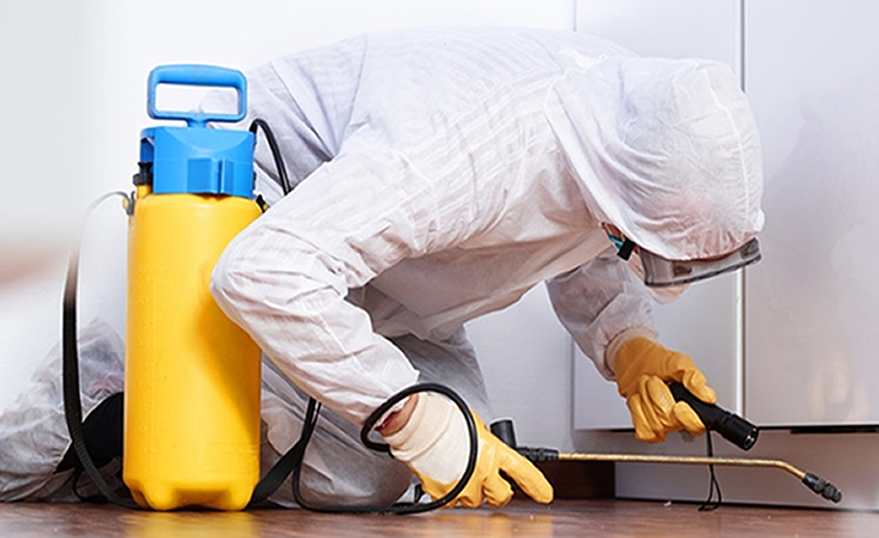Relied On Pest Control Near Me: Quick and Effective Solutions!
Wiki Article
Professional Bug Control Techniques for Long-Term Outcomes
Expert insect control strategies encapsulate an extensive technique that starts with an extensive examination and evaluation, adhered to by specific parasite recognition to understand their behavior patterns. The execution of Integrated Insect Management (IPM) principles, coupled with eco-conscious treatments, forms the keystone of lasting bug removal.Examination and Evaluation
Upon getting in a building for insect control solutions, the first step is an extensive evaluation and analysis to determine the extent of the problem and figure out the most effective treatment strategy. Professional insect control technicians are trained to thoroughly check out the properties, looking for signs of bug task such as droppings, munch marks, nests, or any type of structural damage. They will certainly also examine the conditions that might be attracting bugs, such as food resources, water leaks, or access points.
Bug Recognition and Actions

In addition, comprehending the habits of the identified bug is essential to applying efficient control measures. Recognizing where parasites nest, what they feed on, and their task patterns can help pest control professionals devise methods to eliminate them efficiently.
Integrated Insect Monitoring (IPM)
Integrated Pest Administration (IPM) techniques combine multiple techniques to control and stop insect invasions in a lasting and ecologically friendly way. Pest control Washington DC. By incorporating techniques such as biological control, environment adjustment, modification of cultural practices, and using resistant ranges, IPM intends to lessen the usage of chemical pesticidesAmong the vital principles of IPM is the emphasis on Recommended Site prevention. This aggressive approach entails tracking bug populaces regularly to detect any kind of prospective issues before they intensify. By determining pest troubles early, pest control actions can be carried out quickly and successfully.
Furthermore, IPM advertises using non-toxic bug control approaches whenever possible. This can consist of employing all-natural predators of the pests, introducing valuable bugs, or using pheromones to interfere with mating patterns. By minimizing dependence on chemical pesticides, IPM not only safeguards the atmosphere however likewise helps maintain an equilibrium in the ecosystem.
Environmentally-Friendly Therapies
Executing eco-conscious approaches in bug control treatments can successfully deal with invasions while prioritizing environmental sustainability. Environmentally-friendly treatments concentrate on minimizing the effect of parasite control techniques on ecosystems, non-target microorganisms, and human health.One more trick element of environmentally-friendly therapies is the usage of natural and biodegradable products that break down rapidly without leaving hazardous residues in the atmosphere. Botanical pesticides stemmed from plants like chrysanthemums or neem provide effective parasite control while presenting very little threat to non-target varieties. In addition, utilizing techniques like warm therapies or pheromone catches can target specific bugs with precision, decreasing the general ecological effect of pest control techniques.
Ongoing Monitoring and Maintenance
Continual monitoring and maintenance are necessary elements of efficient parasite control monitoring. Recurring surveillance plays an important duty in making certain that bug problems are discovered early and Our site dealt with immediately. Routine examinations by experienced specialists are necessary to identify any kind of indicators of bug task, evaluate the performance of previous therapies, and make adjustments to the parasite control strategy as required. By keeping an eye on parasite populations in time, parasite control professionals can track trends, prepare for possible problems, and execute precautionary measures to lessen the threat of future invasions.
Along with monitoring, upkeep methods are crucial for long-term bug control success. This includes carrying out proper hygiene steps to eliminate weblink possible food and water sources for pests, sealing entry indicate stop bugs from getting in the properties, and addressing any structural problems that might facilitate insect invasions (pest control). By incorporating ongoing monitoring and maintenance into an incorporated pest management method, organizations can ensure a pest-free environment and safeguard their residential or commercial property against expensive damages and health risks
Final Thought
In final thought, making use of professional insect control strategies such as thorough evaluation and evaluation, exact insect recognition and understanding of their behavior, integrated bug monitoring strategies, environmentally-friendly treatments, and continuous monitoring and maintenance are necessary for attaining lasting lead to bug control. By carrying out these techniques, individuals can effectively handle insect infestations and maintain a pest-free environment in a lasting fashion.Report this wiki page